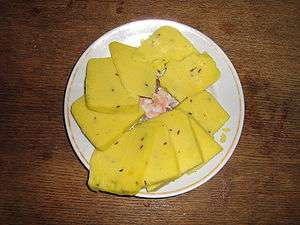Jāņi cheese
Jāņi cheese (Latvian: Jāņu siers) is a Latvian sour milk cheese, traditionally eaten on Jāņi, the Latvian celebration of the summer solstice. Nowadays the cheese has also become one of the symbols of Latvian culture.[1]
| Jāņi cheese | |
|---|---|
 Wheels of Jāņi cheese manufactured by "Rankas piens" | |
| Other names | Caraway cheese (ķimeņu siers) |
| Country of origin | Latvia |
| Source of milk | cows |
| Texture | soft, compact, slightly grainy and homogeneous throughout |
| Fat content | <30% |
| Dimensions | cylinder 4–6 cm in height and 8–30 cm in diameter |
| Aging time | at least 1–2 hours |
| Certification | TSG 2015 |
| Named after | Jāņi |
On November 16, 2015, Jāņi cheese was included in the European Council's Traditional Speciality Guaranteed (TSG) register.[2] Currently 5 manufacturers ("Valmieras piens", "Rankas piens", "Lazdonas piensaimnieks", "Straupe", and "Dundaga") fulfil the TSG criteria and can label their product as Jāņi cheese.[3]
Ingredients
Its basic ingredients are raw quark (Latvian: biezpiens) and fresh milk, but other products may be used as well. Traditionally, caraway seeds are added during cooking as a spice.
Making

The cheese is made by heating whole milk, adding quark, and then cooking the mixture until fluffy curds separate from a clear whey. The whey is discarded when the cheese mass reaches a temperature of 72–77 °C (162–171 °F). At this point, the curds are placed into a skillet or cooking pan, and a mixture of egg, butter, salt, and caraway seeds is stirred into it. Once a solid, firm ball is formed, the cheese is placed in a cheesecloth to drain. Generally, the cheese is prepared a few days before eating, and is allowed to ripen in a cool place before consumption.[4]
References
- "Jāņi cheese – a symbol of Latvian identity". Public Broadcasting of Latvia. June 21, 2019. Retrieved June 22, 2019.
- "Traditional Midsummer cheese wins EU protection". Public Broadcasting of Latvia. November 17, 2015. Retrieved June 23, 2017.
- Matisone, Gunta (May 13, 2016). "How to spot authentic Midsummer cheese". Public Broadcasting of Latvia. Retrieved June 23, 2017.
- Linda Dumpe; Anna Šmite; Aija Golde (2004). Jāņi cheese. Riga: SO „Cheese Club”. p. 204. ISBN 9984-976-20-3.